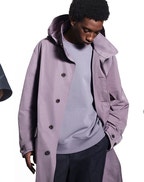Vogue CS in English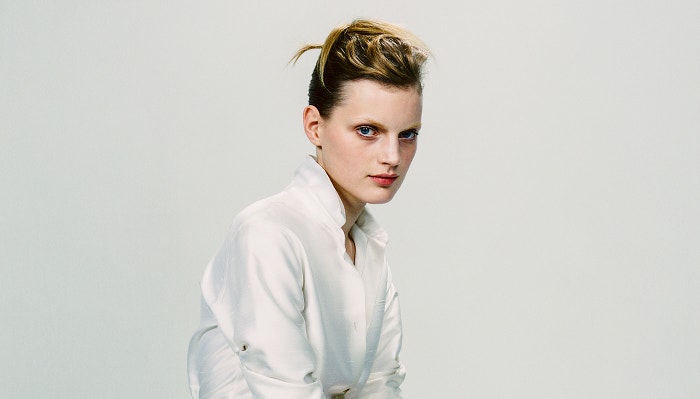
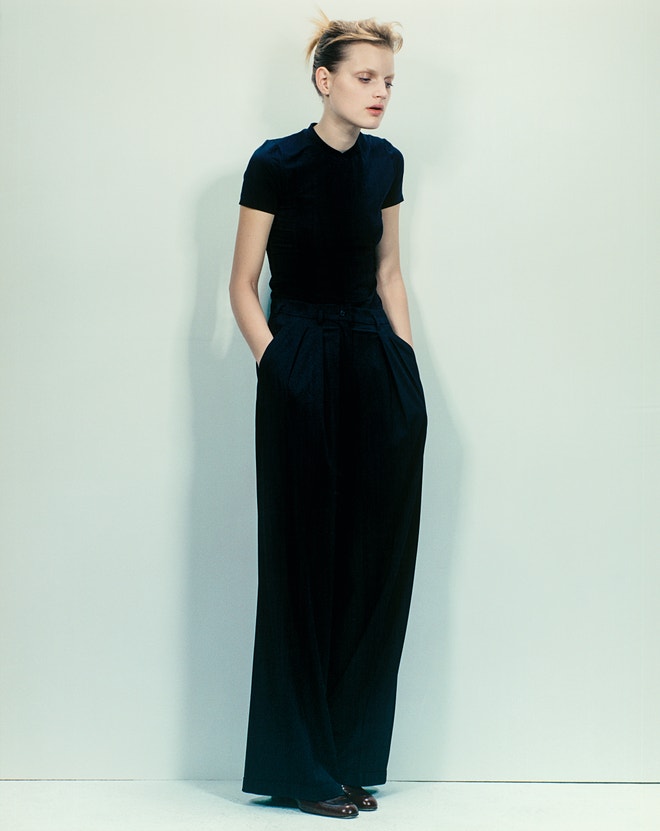
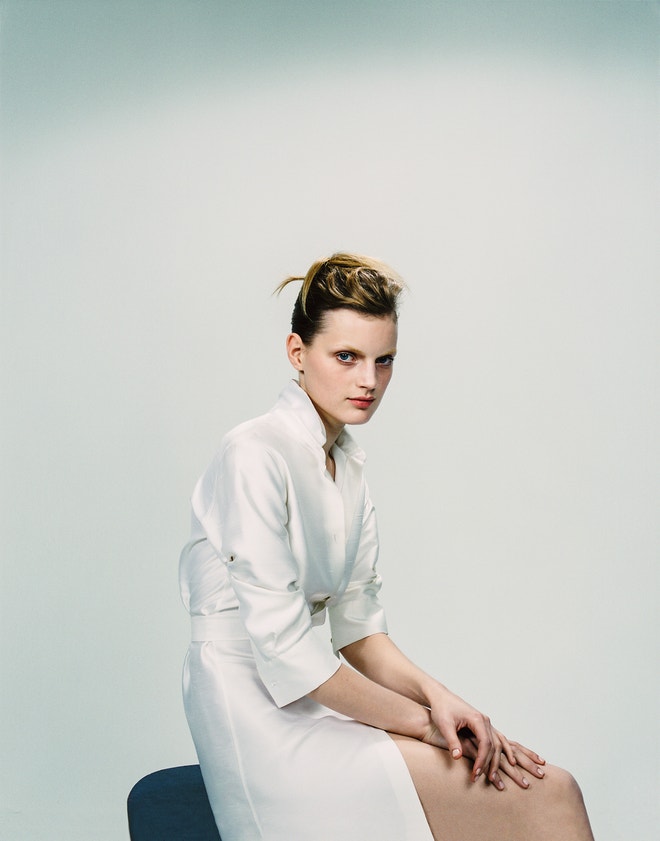
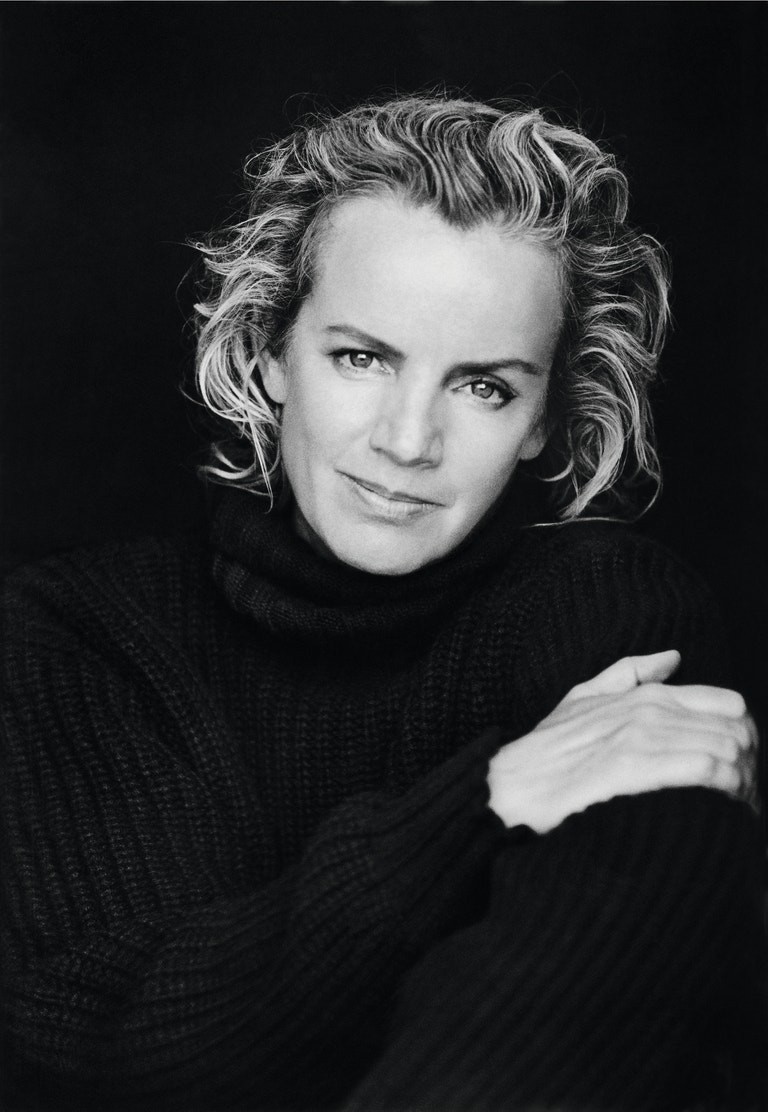
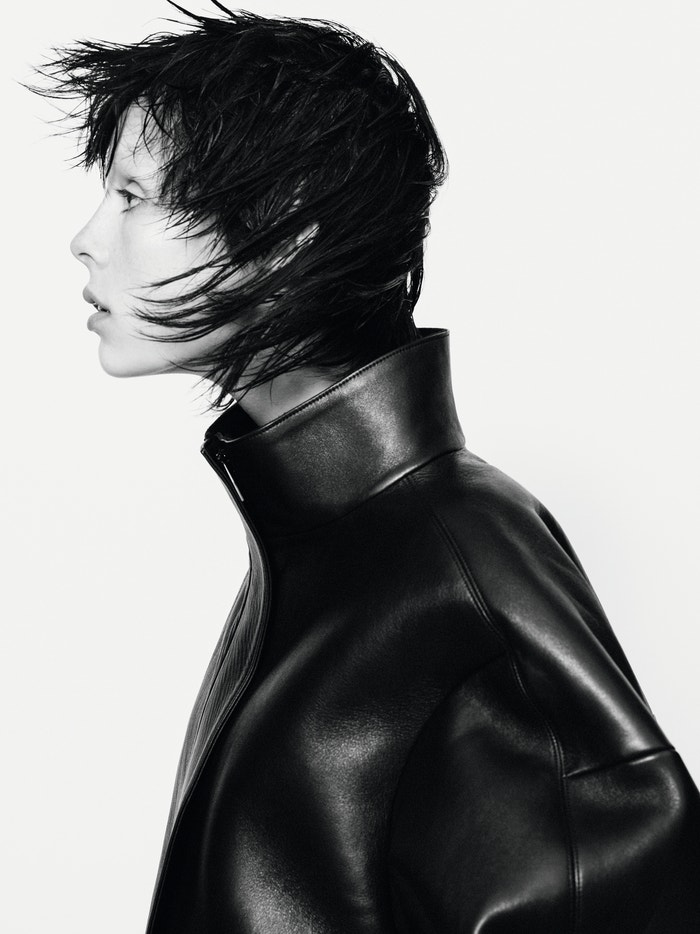
Jil Sander: Be patient and passionate
INGEBORG HARMS16. 3. 2021
Hers is a name we associate immediately with a clean-cut aesthetic. The Queen of Pure Lines entered onto the scene fifty-five years ago and built up her own brand. Today, her new designs are introduced exclusively in cooperation with Uniqlo, under the label +J. Her first ever interview with a Czech magazine opens with questions from local designers.

Foto: Craig McDean
Guinevere van Seenus pro Jil Sander, 1996
Liběna Rochová’s question: What is or was your main thought during your creative process?
I am always focused on keeping the desired quality. I go through many fittings and don’t stop improving. But this is not so much a thought, it’s more an intuitive pursuit of my vision. I have been in fashion for quite a while, so many things are a given to me, but I have to transmit them to my team. That’s why I am explaining and motivating a lot.
Denisa Nová’s question: Is there anything (any kind of pitfall), be it in your work or in your personal life, that you would do differently? Anything that – having known about it – you would be more conscious of, or have paid more attention to? And what does “opportunity” mean to you? Is it important for you? And in what way do you work with it in terms of clothing, collections?
That’s an interesting question. A while ago, I might have said that I would not decide on a joint venture again, which led to my leaving the fashion company of my name. But today, working on the democratic +J collection for Uniqlo, I feel that it doesn’t matter and that new interesting possibilities open up, if you let things go.
There were many lucky instances which I grasped and which helped me in building my company. But first of all, opportunity means for me that times change. As a designer, I have to react to that and be conscious of new values and possibilities. Each collection is the opportunity to enter into conversation with the zeitgeist. I feel that there is a need to be contemporary and also express the living moment in what we wear.
Daniela Pešková’s question: Your vision of clean, minimalistic clothes is very strong, it seems almost unshakeable. Have you ever hesitated? Have you ever been tempted to design (or have you ever designed) something opposing the minimalistic language?
I prefer to speak of pure design, since minimalism is a term in art and artists can be very radical. Since I am designing for the human body, I need to respect it. So, there is a limit to reduction. My vision was born when I was quite young, when I felt that women weren’t dressed for autonomy and a professional life. Since then, they have achieved a lot, so that the need for clean lines and sophisticated understatement is less urgent. My basic vision was never shaken, but there were times when I wanted to integrate ornament and prints in a subtle way, to kind of translate them into a new era.
Andrea Pojezdalová’s question: Which creative period of your professional career has been for you personally the most beneficial or enriching, and why?
To tell the truth, I am so involved in the current production, that it is always the emerging collection that is the most dear to me. It is like a child which cannot walk yet. And it is fed by all my energy and perception. But when I did a museum exhibition of my work a couple of years ago in Frankfurt/Main, we digitized my archive, and I watched videos of our former catwalks. I was struck and quite happy by the timeless modernity of our earlier collections. The vision has always been the same.
Mikuláš Brukner’s question: I wonder whether it ever happens to you that you walk on the street and think: “You people are dressed like that thanks to me.” Do you ever realize the historical role you have played?
Of course, that happens and I am energized by that. But I always want to improve things. I sometimes catch myself rearranging things in the household of friends. And when I watch people, I always think about what needs to be altered for them to look their best. That’s actually already the groundwork for a new collection.
Jakub Patka’s question: Was menswear and tailoring an important basis for you in the early stages of creating and designing your womenswear, and your woman’s identity as a Jil Sander wearer? Do you believe that it is nowadays possible to combine menswear and womenswear via tailoring in order to create a certain universal kind of new formal wear?
You are right, menswear was very important for me. I disliked, for example, that women’s pants weren’t tailored in the same meticulous way as men’s to their respective bodies. Being from Hamburg, which has a cultural affinity to England, I also looked at the British men’s wardrobe, especially tweed jackets. They were quite stiff at first, but after longer use, they took on the sculptural form of the body. I tried to achieve the same effect from the beginning by lighter tailoring.
I am sceptical as to the effacement of the line between female and male fashion. Women’s bodies in general are different and need different proportions. When I did “Jil Sander”, we offered 80% clothing and 20% accessories. With other big luxury houses, the numbers were the opposite in the early 2000’s. One reason for the focus on clothes was that I graded the fits meticulously to different body types all around the world.

Foto: Craig McDean
Guinevere van Seenus pro Jil Sander, 1996

Foto: Craig McDean
Guinevere van Seenus pro Jil Sander, 1996
Be patient and passionate
Was the frenetic interest in your first +J collection after eleven years a surprise?
I never felt that I had lost touch with my customer, and yet, it was a great joy to see that my ideas were still appreciated. The interest in the +J collection meant to me that I had understood something about the present moment, its aesthetic signature and its needs.
How would you describe this moment?
We are looking for clarity in the message, for a certain alertness and space to move freely. Accordingly, the materials are very light, and I concentrated on flexible layering. I also went for cuts and volumes which define the wearer in a sculptural way. Practical aspects are reduced to the essential and turned into attractive signifiers.
Could you give an individual example for the modernity that you seek, for the translation of the contemporary mood into your design?
Early on in my career, I saw an exhibition of the work of the painter Robert Ryman who achieves so much by simply using the color white and giving it structure on the plane. I was deeply impressed and translated this technique into intricate work on the cut and the spatial properties of a design.

Foto: Peter Lindbergh
Jil Sander
In defining your design, you prefer to speak of purity instead of minimalism. Could you say a bit more about that?
Sometimes, fashion can overwhelm and efface the individual. On the other hand, it can underline the personality in a sophisticated way. I try to use design and fabrics in order to bring the essence of a human being into light. This also means that past styles don’t distract from the pure presence of a person. Modernity to me means that someone shows class and coolness if confronted with new problems. Sophistication, personality and a certain urbanism are part of it. Fashion should enhance this personal impression.
In your beginnings, you were your own muse and designed for your own needs. What was it in your work that struck a chord with many women?
In the 60s, while London went through a youth revolution, adult women were stuck in very elaborated styles, which framed them as leisure creatures. Most women didn’t work full time, especially not in leading jobs. Those who did, and looked for more practical clothing, were embarrassed by badly cut pants and fuzzy Madame jackets. Simply to ask yourself: “what doesn’t work?” was the key to changing it. I wanted attractive clothes that evoked respect and protected me in important business negotiations, clothes that didn’t hide my intelligence.
Today, women are much more emancipated. Why do you still hit a nerve with your collections?
The principle of my design stayed the same: I try to read the present moment, my respective needs and dissatisfactions. I don’t believe that historical time moves in circles and that it makes sense to re-adapt retro-fashions. It’s my modernist credo that I believe in evolution and in the necessity to find an expression for the singularity of the contemporary moment. Only if we understand our time, not just rationally, but also in the sensual design of our environment, can we communicate on a common wave and build the future together. That is why I like to speak of a global uniform in the context of +J.
Fabric development is very important to you.
New textiles offer new properties, which in turn inspire new shapes and proportions. Participation in the contemporary moment also relates to the appreciation of research and cutting-edge inventions.
Does the growing awareness of the problem of degradability hamper textile development?
It’s just the opposite. The ecological challenge drives fabric producers to offer innovative materials which respect the environment. And innovative material is an opportunity to design contemporary clothes.
The pandemic made many of us retreat to a more regional existence. Do you think that these experiences will make life more provincial in the future? Since they made us discover a slower life, closer to nature.
I would be glad if we honored and enjoyed regional nature more. I guess that people will balance their lockdown experiences according to what made sense. Of course, we will travel again, but I am positive that our actions will be more conscientious. First of all, we found out to which extent communication can be referred to as digital means. But in some cases, meeting eye to eye will always be preferable.

Foto: David Sims
Edi Campbell pro Jil Sander, 2013
Will the new normal have an influence on the value of a global uniform?
Even if we decide to be less mobile, we still need expressions for the fact that we are all together in this global world and must solve the emerging problems in good faith.
You mentioned the 3D-dimension of your design and cutting. Why do you put so much value on a sculptural form?
Digital media has revolutionized fashion, which has turned into popular culture. The downside of this is that we tend to judge designs by mere photos which leaves a lot of room to the real quality of materials and cuts. Real people are not two-dimensional, their bodies and proportions require thoughtful attention. Pattern-makers have been dying out but, hopefully, in the DIY climate, the trend can be inverted. But many in the younger generation haven’t even experienced the impact of a well-tailored jacket, the feel and also the attractiveness of clothes that respect and highlight the body in an idealized way.
How did you experience the restraints of the pandemic? Did you gain new insights during this period concerning yourself and the world?
As you said: The new regionality. I haven’t left my studio for a year, except for short trips to the countryside. The lockdown was interesting because it made memories from travels and other places more intense. I have the feeling that we had almost forgotten to develop our global experiences, as one develops a photo, because we were too driven and mobile.
Is modernity or avantgarde still an important criteria for fashion? Lately, fashion has been more concerned with ethical content, the environment and the recycling of former styles.
Fashion has almost come to a standstill, it has lost direction a bit. There are so many new issues which have long been ignored. But I think that this moment asks for new answers, not only in an ethical, but also in an aesthetic way. Whatever is modernity in fashion, if not a convincing vestimentary answer to our present values? There are many people working in the fashion industry and it contributes significantly to our global added value. It is paramount that we reconstruct its ways while the machine keeps running. And I believe that the new parameters can be interpreted in an attractive, desirable way. Of course, this can not be achieved in a minute.
Could you say something about your creative work and the satisfactions it provides?
When I stepped down from my fashion house, I had personal reasons. But I knew that I would be unbalanced if I didn’t return to creative work. Designing is like breathing to me, whatever I notice, I notice with an eye that wants to improve. Since my childhood, I feel like being on a mission. I advised my family as to what they should wear. But the mission extends to everything. In my museum show, we included sections on architecture, store design and gardening. As far as time permitted, I redesigned the whole museum.
You like to speak of energy when it comes to your design. How can such a physical phenomenon emerge in a piece of clothing?
That is truly a riddle. But I can feel it. A 3D-design responds to the properties of space and enters into conversation with our environment. But there is also the aspect of the new. If you work a collar in a different way, people are alerted, they look more closely, they are engaged and curious. Modernity is about this moment of waking-up, of questioning the established.
How did you manage to make such a huge global imprint on fashion from a place like Hamburg in a time when fashion was firmly situated in Paris?
Thank you for saying that. But I wasn’t alone. In the 60’s, there was also London with Mary Quant, Biba, Rudy Gernreich, Ossie Clark and many others. Hamburg is a special place, very cosmopolitan, but rooted in the ground. And the atmosphere is special too, the northern light, the business ambiance. I started showing in Paris, but Milan was more appropriate to me and it was closer to my suppliers. I started in a moment of great need for change in women’s dressing, and, in those days, Paris was very much attached to the codes of the past.
Can it be an advantage to work at a distance from fashion centers?
Of course, since you are not caught in the ways of a small elite world. You see the world in a broader light and are more objective.
How did the local influence your work?
I mentioned the Hamburg light. Often, I returned from Italy with fabric samples, and suddenly, they looked disappointing. You can’t hide anything under the clarity of the Hamburg sky. Blacks were no longer black, for example, which made me decide to dye them twice. A certain reserve in appearance is also part of my heritage. You honor the public in showing neatness and self-assurance, but you don’t overdo your expression. I think this is very important today with all the new tensions.
You grew up in a bombed city after the Second World War. Has it influenced your design work?
Germany was on its knees, and everything had to be reconstructed. But there was a joyful aspect to that. You didn’t have to accept dated structures, you could think everything through from scratch. Maybe, that made me like minimalism in art, since it went down to the bone of artistic expression. We didn’t have much, but whenever I was in need of something, I always wanted the best. If you grow up in an erased city, you dream big.
Which advice would you give to young fashion designers?
Be patient and passionate.

